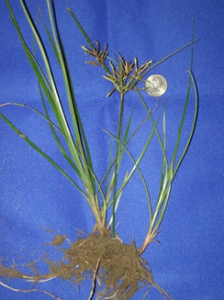Nutsedge is one of those pesky weeds that seems to show up everywhere and is a challenge to get rid of. Nutsedge, also called nutgrass, is a perennial whose leaves die back in the fall and re-sprout in the spring from tubers (“nutlets”) and rhizomes (underground stems) in the soil. It is important to know that nutsedge is a sedge and not a grass because most herbicides for grass control are not effective on sedges. Nutsedge can be identified by looking at the stems. Grass stems are hollow and round, while sedges are triangular or V-shaped. The leaves of nutsedge are thicker and stiffer than most grasses and arranged in groups of three at the base. Unfortunately, nutsedge is not easy to eliminate. It will take a combination of cultural, mechanical, and chemical control over a long period of time to successfully control nutsedge.
Cultural Control: The ideal environment for nutsegde to start in is moist areas with poor drainage or frequent irrigation. Once nutsedge takes hold of an area, it can live in less moist areas and even in drought conditions. Proper lawn care is important in controlling nutsedge because a properly managed lawn will allow the grass to better compete against nutsedge by having less thin, bare spots. Proper lawn practices include mowing at ideal height, proper application of fertilizer and lime, proper irrigation, and having a soil test every 3-5 years to determine if the soil pH is ideal or needs adjusting.
Nutsedge is often accidentally brought into an area on plants, topsoil, sod, and equipment. Learning to identify nutsedge and being on the outlook for it when making purchases for the garden can prevent introducing it to your garden all together.
Mechanical Control: If you have a small patch of nutsedge, you can dig at least 10 inches deep and 8 to 10 inches beyond the infested area to reduce the amount of nutsedge. The dirt could be sifted to remove the “nutlets” or remove the soil from the area all together. Routinely weeding (every couple of weeks) can help slowly reduce the amount of over time.
Chemical Control: Chemically controlling nutsedge depends on if it is located in a lawn, landscape, or vegetable garden. Herbicides labeled for nutsedge vary in their effectiveness. Note that nutsedge is a tough weed to control, and there is not a herbicide that will eliminate it with a single application.
For the lawn, the most common herbicide used is imazaquin (Image). Image has fair control on nutsedge and can be used on all types of warm-season grasses. Other herbicides include bentazon (Basagran) and halosulfuron (SedgeHammer).
For a landscape bed, caution should be used when using a herbicide for nutsedge. Some herbicides can injure foliage or roots of ornamental plants. Herbicides labeled for use in the landscape include: imazaquin (Image), bentazon (Basagran), and halosulfuron (SedgeHammer).
For vegetable gardens, chemical control of nutsedge is not as easy because you are dealing with edible plants. Spot treating with glysophate (Roundup) can be effective between rows. Carefully apply glysophate to prevent drift damage on vegetable plants.
Even though we are seeing nutsedge summer into fall, spring time when it is actively growing, is the best time for attempting control before more tubers are produced. Once nutsedge has more than five or six leaves, they begin to form new tubers underground, usually from May to June.
Recommendations for the use of agricultural chemicals are included in this article as a convenience to the reader. The use of brand names and any mention or listing of commercial products or services in this article does not imply endorsement by North Carolina Cooperative Extension nor discrimination against similar products or services not mentioned. Individuals who use agricultural chemicals are responsible for ensuring that the intended use complies with current regulations and conforms to the product label. Be sure to obtain current information about usage regulations and examine a current product label before applying any chemical.
Jessica Strickland is an Agriculture Extension Agent, specializing in horticulture for North Carolina Cooperative Extension in Wayne County.

(Photo Credit: J. Strickland)

